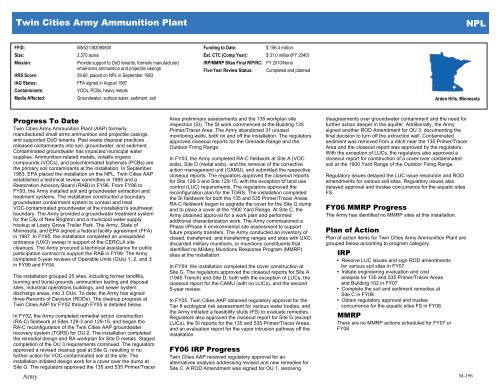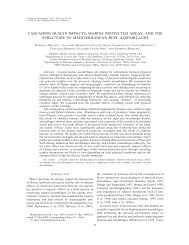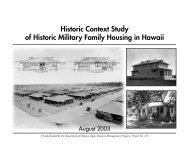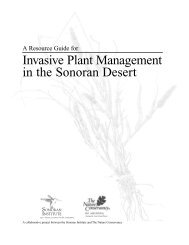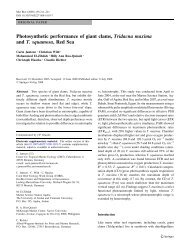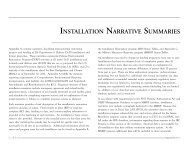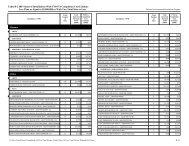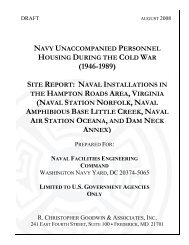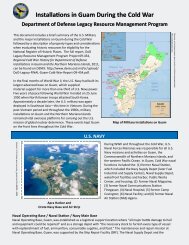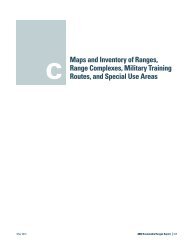Appendix M: Installation Narrative Summaries - denix
Appendix M: Installation Narrative Summaries - denix
Appendix M: Installation Narrative Summaries - denix
You also want an ePaper? Increase the reach of your titles
YUMPU automatically turns print PDFs into web optimized ePapers that Google loves.
„���2g�����2e���2e���������2€�—�� x€v<br />
2ppshX<br />
2ƒ���X<br />
2w������X<br />
2r‚ƒ2ƒ���X<br />
2seq2ƒ�—���X<br />
2g���—���—���X<br />
2w���—2e������X<br />
€�������2„�2h—��<br />
Twin Cities Army Ammunition Plant (AAP) formerly<br />
manufactured small arms ammunition and projectile casings,<br />
and supported DoD tenants. Past waste disposal practices<br />
released contaminants into soil, groundwater, and sediment.<br />
Contaminated groundwater has impacted municipal water<br />
supplies. Ammunition-related metals, volatile organic<br />
compounds (VOCs), and polychlorinated biphenyls (PCBs) are<br />
the primary soil contaminants at the installation. In September<br />
1983, EPA placed the installation on the NPL. Twin Cities AAP<br />
established a technical review committee in 1985 and a<br />
Restoration Advisory Board (RAB) in FY96. From FY86 to<br />
FY93, the Army installed soil and groundwater extraction and<br />
treatment systems. The installation constructed a boundary<br />
groundwater containment system to contain and treat<br />
VOC-contaminated groundwater at the installation's southwest<br />
boundary. The Army provided a groundwater treatment system<br />
for the City of New Brighton and a municipal water supply<br />
hookup at Lowry Grove Trailer Park. The Army, State of<br />
Minnesota, and EPA signed a federal facility agreement (FFA)<br />
in 1987. In FY95, the installation completed an unexploded<br />
ordnance (UXO) sweep in support of the CERCLA site<br />
cleanups. The Army procured a technical assistance for public<br />
participation contract to support the RAB in FY99. The Army<br />
completed 5-year reviews of Operable Units (OUs) 1, 2, and 3<br />
in FY99 and FY04.<br />
The installation grouped 25 sites, including former landfills,<br />
burning and burial grounds, ammunition testing and disposal<br />
sites, industrial operations buildings, and sewer system<br />
discharge areas, into 3 OUs. To date, the Army has signed<br />
three Records of Decision (RODs). The cleanup progress at<br />
Twin Cities AAP for FY02 through FY05 is detailed below.<br />
In FY02, the Army completed remedial action construction<br />
(RA-C) fieldwork at Sites 129-3 and 129-15, and began the<br />
RA-C reconfiguration of the Twin Cities AAP groundwater<br />
recovery system (TGRS) for OU 2. The installation completed<br />
the remedial design and RA workplan for Site D metals. Staged<br />
completion of the OU 3 requirements continued. The regulators<br />
approved a revised cleanup goal at Site G, resulting in no<br />
further action for VOC-contaminated soil at the site. The<br />
installation initiated design work for a cover over the dump at<br />
Site G. The regulators approved the 135 and 535 Primer/Tracer<br />
Army<br />
wxSPIQVPHWHVHH<br />
PDQUH2—���<br />
€������2�������2��2h�h2���—���Y2��������2�—���—�����2<br />
��—��E—���2—���������2—��2���������2—�����<br />
SWFTHY2��—��2��2x€v2��2ƒ�����˜��2IWVQ<br />
ppe2������2��2e�����2IWVU<br />
†yg�D2€gf�D2��—��2���—��<br />
q������—���D2����—�2�—���D2��������D2����<br />
2p������2��2h—��X<br />
62ISTFR2�������<br />
2i��F2g„g2@g���2‰�—�AX 62QIFH2�������@p‰2PHRHA<br />
2s‚€Gww‚€2ƒ����2p��—�2‚s€G‚gX p‰2PHIHGx���<br />
2p���E‰�—�2‚�����2ƒ�—���X g��������2—��2��—����<br />
Area preliminary assessments and the 135 workplan site<br />
inspection (SI). The SI work commenced at the Building 135<br />
Primer/Tracer Area. The Army abandoned 31 unused<br />
monitoring wells, both on and off the installation. The regulators<br />
approved closeout reports for the Grenade Range and the<br />
Outdoor Firing Range.<br />
In FY03, the Army completed RA-C fieldwork at Site A (VOC<br />
soils), Site D (metal soils), and the removal of the corrective<br />
action management unit (CAMU), and submitted the respective<br />
closeout reports. The regulators approved the closeout reports<br />
for Site 129-3 and Site 129-15, with the exception of land use<br />
control (LUC) requirements. The regulators approved the<br />
reconfiguration plan for the TGRS. The installation completed<br />
the SI fieldwork for both the 135 and 535 Primer/Tracer Areas.<br />
RA-C fieldwork began to upgrade the cover for the Site G dump<br />
and to place a cover at the 1900 Yard Range. At Site C, the<br />
Army obtained approval for a work plan and performed<br />
additional characterization work. The Army commissioned a<br />
Phase I/Phase II environmental site assessment to support<br />
future property transfers. The Army conducted an inventory of<br />
closed, transferred, and transferring ranges and sites with UXO,<br />
discarded military munitions, or munitions constituents that<br />
identified no Military Munitions Response Program (MMRP)<br />
sites at the installation.<br />
In FY04, the installation completed the cover construction at<br />
Site G. The regulators approved the closeout reports for Site A<br />
(1945 Trench) and Site D, both with the exception of LUCs, the<br />
closeout report for the CAMU (with no LUCs), and the second<br />
5-year review.<br />
In FY05, Twin Cities AAP obtained regulatory approval for the<br />
Tier II ecological risk assessment for various water bodies, and<br />
the Army initiated a feasibility study (FS) to evaluate remedies.<br />
Regulators also approved the closeout report for Site G (except<br />
LUCs), the SI reports for the 135 and 535 Primer/Tracer Areas,<br />
and an evaluation report for the vapor intrusion pathway off the<br />
installation.<br />
p‰HT2s‚€2€�������<br />
Twin Cities AAP received regulatory approval for an<br />
alternatives analysis addressing revised and new remedies for<br />
Site C. A ROD Amendment was signed for OU 1, resolving<br />
disagreements over groundwater containment and the need for<br />
further action deeper in the aquifer. Additionally, the Army<br />
signed another ROD Amendment for OU 3, documenting the<br />
final decision to turn off the extraction well. Contaminated<br />
sediment was removed from a ditch near the 135 Primer/Tracer<br />
Area and the closeout report was approved by the regulators.<br />
With the exception of LUCs, the regulators also approved a<br />
closeout report for construction of a cover over contaminated<br />
soil at the 1900 Yard Range of the Outdoor Firing Range.<br />
Regulatory issues delayed the LUC issue resolution and ROD<br />
amendments for various soil sites. Regulatory issues also<br />
delayed approval and trustee concurrence for the aquatic sites<br />
FS.<br />
p‰HT2ww‚€2€�������<br />
The Army has identified no MMRP sites at this installation.<br />
e����2r����D2w�������—<br />
€�—�2��2e����<br />
Plan of action items for Twin Cities Army Ammunition Plant are<br />
grouped below according to program category.<br />
22222s‚€<br />
0 Resolve LUC issues and sign ROD amendments<br />
for various soil sites in FY07.<br />
0 Initiate engineering evaluation and cost<br />
analysis for 135 and 535 Primer/Tracer Areas<br />
and Building 102 in FY07.<br />
0 Complete the soil and sediment remedies at<br />
Site C in FY08.<br />
0 Obtain regulatory approval and trustee<br />
concurrence for the aquatic sites FS in FY08.<br />
22222ww‚€<br />
There are no MMRP actions scheduled for FY07 or<br />
FY08.<br />
M-196


